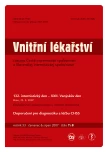Subclinical thyroids disease
Authors:
V. Zamrazil 1,2
Authors‘ workplace:
Endokrinologický ústav Praha, ředitel doc. MUDr. Vojtěch Hainer, CSc.
1; Subkatedra endokrinologie IPVZ Praha, přednosta prof. MUDr. Václav Zamrazil, DrSc.
2
Published in:
Vnitř Lék 2007; 53(7-8): 795-798
Category:
Overview
Subclinical thyroids disease (STD) is recently defined term in clinical thyroidology, which includes mainly functional disorders. Basic diagnostic signs are: normal values of thyroid hormones (fT4, fT3) and elevated TSH level (subclinical hypothyroidism) or suppresed TSH level (subclinical hyperthyroidism). In a category of STD may be included subclinical autoimunne thyroiditis (elevated level of thyroid antigens antibodies and/or hypoechogenity in sonographic screen, increased volume of the thyroid without clinical symptoms and/or autoimminity) and microscopic lesions of papillary thyroid carcinoma. Subclinical hypothyroidism may be dangerous for tendency to development of manifest hypothyroidism and for risk of disorders of lipid profile and development of atherosclerosis and its organ complication (esp. myocardial infarction). Subclinical hyperthyroidism is a risk factor of cardiac arythmias and probably can increase a risk of cardiovascular mortality) as well for osteoporosis (esp. in peri- and post-climacteric women), and last but not least for degenerative diseases of brain (?). Indication of treatment of STD is a matter of controversies. Recomendations of experts, varied from “no therapy, monitoring only” to “treat always”. Treatment of risk groups (esp. pregnant women) is probably nowadays a most rationale recommendations since results of sofisticated prospective studies will be available.
Key words:
hypothyroidism - hyperthyroidism - autoimmune thyroid disease - diagnosis - therapy
Sources
1. Biondi D, Palmieri EA, Klein M et al. Subclinical hypothyroidism. Clinical features and treatment options. Eur J Endocrinol 2005; 160: 526-534.
2. Biondi B, Palmieri EA, Lombardi G et al. Effects of subclinical thyroid dysfunction on the heart. Ann Intern Med 2002; 137: 904-914.
3. Cappola AR, Fried LP, Arnold AM et al. Thyroid status, cardiovascular risk and mortality in older adults. JAMA 2006; 295: 1033-1041.
4. Casey BM, Dashe JS, Wells E et al. Subclinical hypothyroidism and pregnancy outcomes. Amer Coll Obster Gynecol 2005; 291: 239-243.
5. Coll NF, Surks MI, Daniels GH Subclinical thyroid disease. JAMA 2004; 291: 239-243.
6. Cooper DS. Subclinical thyroid disease: concensus or condrum. Clin Endocrinol 2004; 60: 410-412.
7. Drbalová K, Herdová K, Pačesová P et al. Subklinické tyreopatie. Vnitř Lék 2006; 52: 963-968.
8. Duntas LH. Subclinical thyroid disorders: the menace of Trojen horse. J Clin Invest 2003; 36: 47-48.
9. Gharib H, Tutte RM, Baskin HY et al. Concensus statement: Subclinical thyroid dysfunction. A joint statement on management from the American Association of Clinical Endcrinologists, the American Thyroid Association and The Endocrine Society. J Clin Endocrinol Metab 2005; 90: 581-588.
10. Heemestra KA, Smit JWA, Eustatia Rutlen CFA et al. Glucose tolerance and lipid profile in longterm exogenous subclinical hyperthyroidism and the effects of restoration of euthyroidism a randomized controlled study. Clin Endocrinol 2006; 65: 737-743.
11. Hollowell J, Staehling NW, Flanders WD et al. Serum TSH, T4 and thyroid antibodies in The United States population (1988 to 1994): National Health and nutrition Survey (NHA-NESIII). J Clin Endocrinol Metab 2002; 87: 484-499.
12. Chueitl VB, Romaldini JH, Ward LS. Subclinical hypothyroidism increases the risk for depresion in the elderly. Arch Gerontol Geriat 2007; 44: 21-28.
13. Jorde R, Waterloo K, Storhant H et al. Neuropsychological function and symptoms in subjects with subclinical hypothyroidism and the effects of thyroxine treeatment. J Clin Endocrinol Metab 2006; 91: 145-157.
14. Kalmiju S, Mehta KM, Pols HAP et al. Subclinical hyperthyroidism and the risk of dementia. The Rotterdam study. Clin Endocrinol 2000; 53: 733-737.
15. Mayer O jr. Je subklinická hypotyreóza rizikovým faktorem kardiovaskulárních chorob? Cor Vasa 2004; 46: 123-127.
16. Owecki M, Michalek A, Miksch E et al. Prolonged ventricular repolarization measured by corrected QT interval (QTc) in subclinical hyperthyroidism. Horm Metabob Res 2006; 38: 38-43.
17. Pinchera A Subclinical thyroid disease to treat or not to treat. Thyroid 2005; 1: 1-2.
18. Ringel D, Mazzaferri EL. Subclinical thyroid dysfunction - can there be a consensus about consensus: editorial. J Clin Endocrinol Metab 2005; 90: 588-590.
19. Rodondi N, Aujesky D,Vittingoff E et al. Subclinical hypothyroidism and the risk of coronary heart disease: A meta analysis. Amer J Med 2006; 119: 541-551.
20. Sawin CT, Geller A, Wolf PA et al. Low serum thyrotropin concentration as a risk factor for atrial fibrilation in older persons. N Engl J Med 1994; 331: 1249-1252.
21. Schroner Z, Lazúrová I. Diabetes mellitus a subklinické poruchy funkce štítné žlázy. DMEV 2006; 1: 7-12.
22. Surks MI. Commentary: Subclinical thyroid dysfunction A joint statement of management from the American Association of Clinical Endocrinologists The American Thyroid Association and the Endocrine Society. J Clin Endocrinol Metab 2005; 90: 586-587.
23. Surks MI, Oritz E, Daniels GH et al. Subclinical thyroid disease. JAMA 2004; 291: 228-238.
24. Tauchmanová L, Nizzo V, Fonderico F et al. Reduced bone mass detected by bone utrasonography and DEXA in pre- and postmanopauzal women with endogenos subclinical hyperthyroidism. Maturites 2004; 3: 299-306.
25. Turhan S, Tuhernay C, Cin MO et al. Effects of thyroxine therapy on right ventricular systolic and diastolic function in patients with subclinical hypothyroidism a study by pulsed wave tissue Doppler imaging. J Clin Endocrinol Metab 2006; 91: 3490-3493.
26. Walsh JP, Brenner AP, Bulsera MK et al. Subclinical thyroid dysfunction and blood pressure a community based study. Clin Endocrinol 2006; 65: 486-491.
27. Zamrazil V. Subklinické tyreopatie. Interní medicína pro praxi 2004; 6: 295-299.
28. Zhu DF, Wang ZX, Zhang DR. fMRI revealed neural substrate for reversible working memory dysfunction in subclinical hypothyroidism. Brain 2006; 129: 2923-2930.
Labels
Diabetology Endocrinology Internal medicineArticle was published in
Internal Medicine

2007 Issue 7-8
Most read in this issue
- Hypopituitarism – substitution therapy
- Autoimmune polyglandular syndromes: clinical aspects
- Aspiration cytology of the thyroid
- Randomly discovered enlargement in the region of sella turcica
